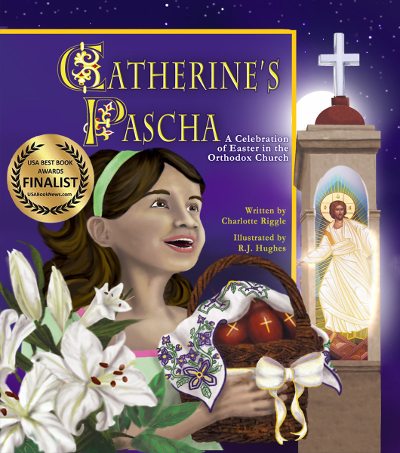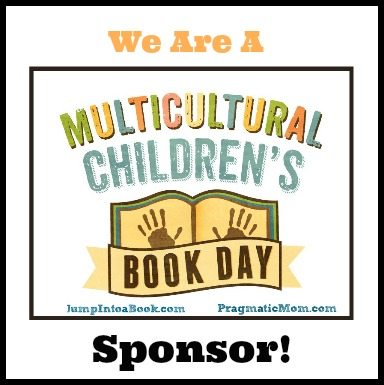“The color of Holy Week is purple.”
That was the unexpected beginning of Sawdust Carpets by Amelia Lau Carling. It was unexpected because nothing on the book’s cover or title page suggested an Easter story to me. But there it was. On the first page, in the very first sentence, we are told that it’s an Easter story.
But perhaps the cover would have told you more than it told me. The two little girls on the cover are standing on a board stretched across what must be a sawdust carpet. The girls are sifting red sawdust onto a butterfly that is part of the beautiful, intricate design.
In Antigua, Guatemala, and in other places, people create these carpets on the streets on Maundy Thursday. The carpets provide a beautiful, if transient, backdrop for the Holy Friday processions.
I didn’t know that. And the little girl who narrated the story didn’t either. Her aunt told her that the carpets were made for the processions, but she didn’t understand that these labors of love were made to be trampled underfoot.
The little girl is sweet and charming. She must be about four years old. Her family, it seems, has immigrated to Guatemala from China. They all speak both Spanish and Chinese. But the narrator’s older sister reads only Spanish, and their mother reads only Chinese.
They’re invited to visit their aunt and uncle in Antigua for Holy Week and Easter, when the new baby will be baptized.
On Maundy Thursday, the children watch their neighbors create sawdust carpets. Don Ortiz lets the narrator help, and early on Friday morning, he asks if they’d like to use the leftover sawdust to make their own carpet. There’s a small open space, and the children take sawdust and flower petals, flowers and fruit to make a carpet with a little house under a starry sky.
And then the processions begin.
At the thunder of a great big drum, pon … pon … pon, the cucurochos lifted a huge wooden platform onto their shoulders. On it a statue of Jesus carried the Cross. He was surrounded by orchids and mosses from the forest. His eyes shone and my heart beat pon… pon. His crown of thorns and the blood on his face made me quiver. The people outside the church fell on their knees.
And then the little girl understands that all the carpets, including her carpet, will be trampled and destroyed.
Of course, the story doesn’t end there. Before it ends, the sorrow of Good Friday is transformed into the joy of Easter.
There is so much to love about this book. If I were a classroom teacher or school librarian, I’d want to add it to my collection. Along with a truly delightful story, the children would get a little geography and a little world culture. They’d get a taste of immigrant experience, and see the challenges of a family that is less than completely bilingual. They would see a familiar holiday celebrated in an unfamiliar way.
But if I were looking or a gift for my godchild, I would think hard about the book. In the prayer corner at the aunt and uncle’s house, there is both a statue of the Virgin of Guadalupe and a statue of Kuan Yin, the Chinese Buddhist goddess of mercy.
I wouldn’t want to give the book to my godchild without addressing this. A Christian cannot worship other gods. And yet St. Paul said, in his letter to the Romans, “Who are you to pass judgment on the servant of another? It is before his own master that he stands or falls. And he will be upheld, for the Lord is able to make him stand.”
So what are we to do with a Roman Catholic family with Kuan Yin in the prayer corner?
I think, perhaps, that I would use the book as an opportunity to talk to my godchild about accepting and loving other people, even when they make choices that I find deeply problematic. I might start by asking questions.
Why would the family have both the Theotokos and a Buddhist goddess in their prayer corner? For us, idolatry is a serious sin. But the child, who is visiting the home, calls Kuan Yin “our goddess.” Perhaps the child’s family is Buddhist, and the relatives they’re visiting have converted to Catholicism. Perhaps they have placed the statue in the prayer corner out of love for their Buddhist relatives.
Learning to hold oneself to a high standard, while not judging others, is a difficult task. The task is, perhaps, made a little easier by practicing it with the characters in a story.
Read More
Easter Picture Books Keep Pascha Present: You might be tempted to put the Easter picture books away during Bright Week. Don’t do it! By keeping them out, you’ll help your little one understand that Easter lasts more than a single day.
The complete list of multicultural Easter picture books: If you’re looking for picture books that show people celebrating the Resurrection of our Lord Jesus Christ, you’ll find them on this list. All of them. (Well, almost all.)
17 essential picture books for Orthodox Christian kids: If you’re looking for picture books that include stories about Orthodox Christian people and traditions, you’ll find them on this list.
Buy the Book: Catherine’s Pascha
FINALIST IN THE 2015 USA BEST BOOK AWARDS
Catherine doesn’t like vegetables. She doesn’t like naps. She doesn’t like it when her mom combs her hair. She loves hot dogs, chocolate cake, and her best friend, Elizabeth. Most of all, she loves Pascha! Pascha, the Orthodox Christian Easter, is celebrated in the middle of the night, with processions and candles and bells and singing. And Catherine insists that she’s not a bit sleepy.
Celebrate the joy of Pascha through the magic of a book: Catherine’s Pascha. Available on Amazon, Bookshop.org, and my webstore.





I think it is important to introduce children to how other culture celebrate the holidays. It helps give children a more worldly view that may be similar or different. I wouldn’t hesitate to give this book. For me, we all worship the same God, no matter what name we use. Love the butterflies in the carpet, symbolizing transformation. Lovely review, and I understand your concern.
This is such a special book and for me it is a wonderful way to introduce children to different cultural traditions within both a Christian context and more broadly in the way that different religions can sit side by side within the same family – I agree that the book offers these up for discussion and this ecumenical aspect would actually encourage me to give it to my godchildren – I wish I had known about it when my god-daughters were small! Thank you for sahring with #DiverseKidLit